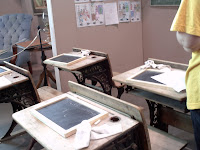 La Prisonniere
La Prisonniereby Malika Oufkir (and Michele Fitoussi)
Bantam Books 2001
Malika Oufkir was born in 1953 to General Muhammed Oufkir and Fatima Chenna in Rabat, Morocco. General Oufkir was the advisor of King Muhammed V and later advisor to Muhammed's son King Hassan II.
Malika was the eldest of 6 children - her younger sisters Myriam, Maria (aka Mouna-Inna) and Soukaina and 2 younger brothers, Raouf and Abdellatif. Abdellatif was the youngest born in 1969.
When Malika was 5 years old, she was taken from her family home and sent to the royal palace, where she became a companion to King Muhammed's youngest daughter Lalla Mina (Meriem). Malika remained at the place for 10 years. During this time Mina and Malika were educated by a private tutor.
By the age of 15, (in 1968) Malika was becoming lonely and feeling abandoned by her family. So she pleaded with King Hassan to be allowed to return home. He gave his permission and Malika then spent 3 years at home getting to know her younger siblings all over again.
In 1972 Muhammed Oufkir (for reasons known only to himself) attempted a coup-de-tat to overthrow King Hassan. He was shot for his actions. His family - wife and all 6 children - were sent into exile in the deserts of Morocco.
Malika describes how they spent 1 year in the southern desert town of Assa, and then were moved to an old abandoned fortress in the high Atlas mountains not far from Ourazazate for 3 years. In 1977 the family were then moved to a place called Bir Jdid prison. A Barracks complex with cells. Up until now the family had been allowed to stay together. They had a small radio, books, reasonably good food, paper to write on, and were reciving some letters rom the outside. But when they were moved to Bir-Jdid, they were separated from each other and totally cut off from the world. Bir-Jdid was about 45 km south of Casablanca.
They were put into separate cells in small groups and were not allowed to see each other in person for almost 10 years. Fatima (the mother) and Abdellatif (the youngest child) were in one cell. Malika and her three sisters were in a second cell and Raouf the eldest son was in a cell on his own. With no books, no paper, and no windows, they lived in these cells for the next 10 years. The family quickly set up a device between the cells that allowed them to communicate. There was one radio which always had to be hidden away when the guards came around. The radio and Malika's stories allowed the Oufkir family to keep their sanity. Each cell was allowed out for exercise - but always on different days so they never met in person. The food was terrible and naturally they became ill. They were also starved and their bodies became like skin and bones.
In early 1987 after 9 years in this prison, they were finally able to escape by digging a tunnel. I'm not sure why they did not dig a tunnel earlier, I cant remember that Malika explains that.
Anyway 4 of the family escaped - Malika, Abdellatif, Maria and Raouf. They went to Casablanca, and Rabat and then to Tangiers. But every time they turned to their old friends, they were shunned. Finally they had to call on their family for help. But 5 days after their escape the police caught up with them. One of their friends had reported them to the authorities. While they were outside, Malika had managed to call one of the Radio stations in France and tell their story. This meant that France started asking questions. So when the 4 of them were recaptured, they were taken back to Casablanca and the entire family was then taken to a large house on the outskirts of Rabat where they were under house arrest. They lived here for another 4 years.
In 1991 The king finally pardoned them. Not because they kept asking - which they did - but because of the international uproar over their treatment and long imprisonment. The King was being embarrased about the way the political prisoners were being treated. So he was forced to set them free.
But they were not free. They spent 5 years back in Rabat being followed, spied on and had their phones tapped. In 1996 Maria escaped from Morocco to France via Spain, and again told the French her story. More uproar and eventually some members of the family were permitted to leave Morocco and move to France.
Malika now lives in Paris with her husband Eric Bordreuil. Malika was 19 when she was imprisoned. She was 43 when she was finally allowed to emigrate to France.
There is some criticism of this story - where some people simple refuse to beleive it. But Malika does say - I have not told everything that happened because they would not beleive me.
Time Magazine June 2001
I read this for the In Their Shoes Challenge
































